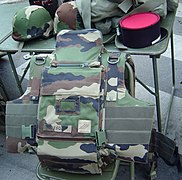| Camouflage Central-Europe | |
|---|---|
 A CCE swatch fabric sample | |
| Type | Military camouflage |
| Place of origin | France |
| Service history | |
| In service | 1994–present |
| Used by | See Users |
| Wars | Bosnian War War in Afghanistan (2001–2021) Operation Serval |
| Production history | |
| Manufacturer | 1991–present |
| Variants | See § Variants |
The Camouflage Central-Europe (French : Camouflage Centre-Europe) is the standard camouflage pattern of the French Armed Forces. [1]
Contents
It is also used for vehicles of the French Army but with different shapes, since 1986, [2] it took six years to generalize it to the entire military fleet. It is now being replaced since 2020 by the "Scorpion Camouflage" which is intended for new generation vehicles. [3]



